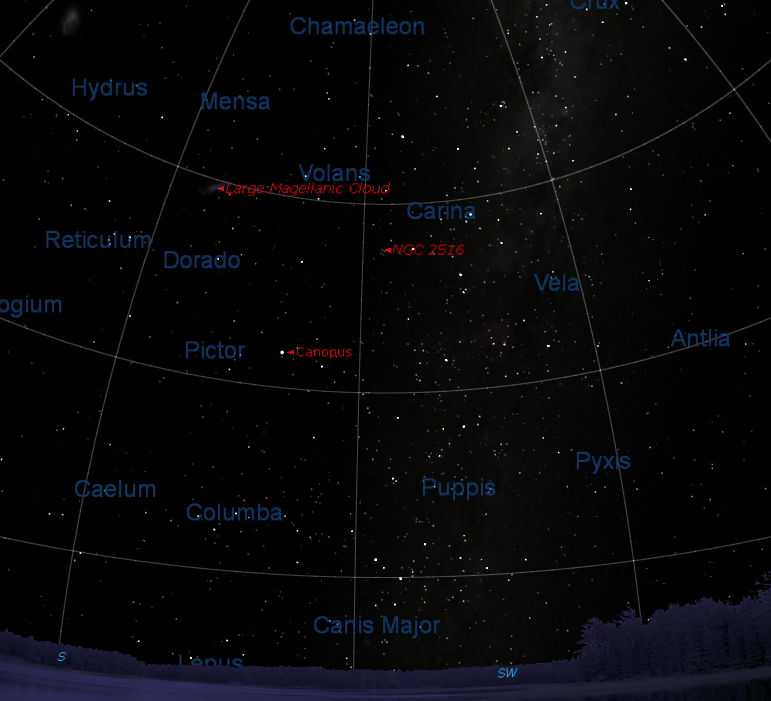
Posted on 07/26/2015 9:41:25 PM PDT by SunkenCiv
Explanation: It has been one of the better skies of this long night. In parts of Antarctica, not only is it winter, but the Sun can spend weeks below the horizon. At China's Zhongshan Station, people sometimes venture out into the cold to photograph a spectacular night sky. The featured image from one such outing was taken in mid-July, just before the end of this polar night. Pointing up, the wide angle lens captured not only the ground at the bottom, but at the top as well. In the foreground is a colleague also taking pictures. In the distance, a spherical satellite receiver and several windmills are visible. Numerous stars dot the night sky, including Sirius and Canopus. Far in the background, stretching overhead from horizon to horizon, is the central band of our Milky Way Galaxy. Even further in the distance, visible as extended smudges near the top, are the Large and Small Magellanic Clouds, satellite galaxies near our huge Milky Way Galaxy.
(Excerpt) Read more at apod.nasa.gov ...
[Credit and Copyright: LI Hang]
Beautiful, and people say there’s no God.
That’s beautiful!
Wow, beautiful shot. Weird though.
Although Wiki doesn't say, I think both of these dwarf satellite galaxies contain a few 10s of billions of stars apiece, as opposed to roughly 200-300 billion stars in our Milky Way Galaxy.
"The Large Magellanic Cloud (LMC) is a nearby galaxy, and a satellite of the Milky Way.[5] At a distance of 50 kiloparsecs (≈163,000 light-years),[6][7][8][2] the LMC is the third closest galaxy to the Milky Way, with the Sagittarius Dwarf Spheroidal (~ 16 kiloparsecs) and the putative Canis Major Dwarf Galaxy (~ 12.9 kiloparsecs, though its status as a galaxy is under dispute) lying closer to the center of the Milky Way. The LMC has a diameter of about 14,000 light-years (~ 4.3 kpc) and a mass approximately 10 billion times the mass of the Sun (1010 solar masses), making it roughly 1/100 as massive as the Milky Way.[3] The LMC is the fourth largest galaxy in the Local Group, after the Andromeda Galaxy (M31), the Milky Way, and the Triangulum Galaxy (M33)."--Wikipedia
____________________________________________
"The Small Magellanic Cloud (SMC) is a dwarf galaxy near the Milky Way.[4] It is classified as a dwarf irregular galaxy. It has a diameter of about 7,000 light-years,[5] contains several hundred million stars,[6] and has a total mass of approximately 7 billion times the mass of the Sun.[7] The SMC contains a central bar structure and it is speculated that it was once a barred spiral galaxy that was disrupted by the Milky Way to become somewhat irregular.[8] At a distance of about 200,000 light-years, it is one of the Milky Way's nearest neighbors. It is also one of the most distant objects that can be seen with the naked eye."--Wikipepedia
"The Small Magellanic Cloud (SMC) is a dwarf galaxy near the Milky Way.[4] It is classified as a dwarf irregular galaxy. It has a diameter of about 7,000 light-years,[5] contains several hundred million stars"
I have trouble buying this as a single exposure. It does check out pretty much as to time and place, but its 180 X 90 degree swath is hard to figure, especially with the deep exposure of the Milky Way.
I can do a piece by piece comparison with the Starry Night view, but I have to roll it around, and it changes the projection as I do so. Well, I can’t point to any single thing, unless it’s the fakey look of that guy in the orange parka!
What is that at the top of the photo? It looks like the same sandy terrain that is at the bottom.
Wouldn’t it be more appripriate to display the pic upside down so we could more easily put it in context?
Wouldn’t it be more appropriate to display the pic upside down so we could more easily put it in context?
You can get that wide with an 18mm lens, and if it’s positioned correctly you would not get huge distortion. I am assuming a 35mm sized sensor.
**a dwarf galaxy**
Are we supposed to say th? Shouldn’t it be little galaxy?
Siriusly, this is fabulous!
Half-pint galaxy.
**a dwarf galaxy**
Are we supposed to say that? Shouldn’t it be little galaxy?
___________________________________________
GEORGE: (to Mickey) Can’t you just switch with another Midget?
(Mickey grabs the counter with rage on his face, Jerry does a form of gulp)
MICKEY: (turns and moves up to George, points his finger at him) It’s little people, you got that?
;’)
Y’know, I was half asleep when I posted it... that is really weird-lookin’... sez the photographer pointed the wide-angle straight up, which is why there’s ground at top and bottom of the shot...
But anyway, I have the same impression from a good many of these mixed-terrestrial shots.
Thanks ETL.

From the opposite horizon, the bright star below the Large Magellanic cloud is Canopus. Sirius is just below the opposite horizon, off the top of the picture as presented.

Note that NGC 2516 is partly resolved in the APOD. I think the panorama was not a pan and scan, but was put together from a series of "flat" shots.
Disclaimer: Opinions posted on Free Republic are those of the individual posters and do not necessarily represent the opinion of Free Republic or its management. All materials posted herein are protected by copyright law and the exemption for fair use of copyrighted works.